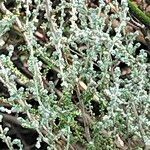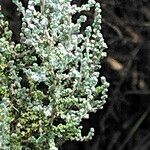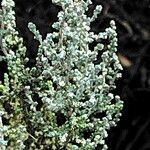Much-branched, grey shrub, 1.0-1.5 m high. Stems with short-shoots in leaf-axils, ± woolly. Leaves on main stems patent, up to 3 mm long, slender, subulate, straight or slightly twisted, often pungent, acuminate or obtuse, involute; densely woolly above, glabrous to cobwebby below; those on short-shoots ± half length of main leaves, blunt or slightly mucronate. Capitula grouped in small heads in axils of main leaves forming a spike-like or branched inflorescence; involucral bracts in several rows, outermost short and leaf-like, innermost scarious, brown, acuminate, longer than florets. Florets brownish ± 2 mm long. Flowering time Mar.-May. Pappus of ± 12 bristles. Cypselae 5-ribbed, scabrid.
Shrub, 1.0-1.5 m high; grey-green, vegetative parts differentiated into long and short shoots. Leaves alternate, sessile; blade ericoid, straight or slightly twisted, margins involute, upper surface persistently white-woolly, lower surface glabrescent or persistently cobwebby, leaves of short shoots ± half length of main leaves. Heads discoid, 1-flowered, few in a spike-like or branched inflorescence. Involucral bracts in several series, imbricate, acute, innermost bracts brown. Flowers: brownish, purple-tipped; Jan.-May, Dec. Fruit with cypsela oblong, thickly 5-ribbed, pubescent. Pappus of several, delicate, plumose bristles, fused in a ring at base.
Much-branched, woody, grey or green shrub, up to 1.0(-1.5) m high. Leaves in fascicles; subtending leaves ovate to triangular, involute, up to 3 mm long; densely woolly above, cobwebby to almost glabrous below. Capitula grouped in small clusters in axils of leaves, terminal on main shoots; sometimes forming a spike-like inflorescence, but more often a panicle; involucral bracts in a few rows; innermost brown, scarious. Disc florets bisexual, up to 2 mm long, purple or brown; lobes small, erect. Nectaries absent. Flowering time mainly Apr., May. Pappus of ± 12 setae, slightly joined at base. Cypselae 5-ribbed, scabrid.
A much-branched, erect shrub up to 1.5 m high. Stems with short-shoots in axils of leaves, shortly woolly. Leaves minute < 1 mm in length; deltoid on main stems, fleshy, slightly gibbous at base, concave above, green and glabrous on lower surface; smaller on short-shoots. Capitula many, borne singly or in small groups in axils of main shoots; involucral bracts in several rows, innermost scarious, brown, acute slightly longer han corolla. Florets purplish brown ± 2 mm long. Flowering time Feb.-June. Pappus of ± 12 bristles. Cypselae with 5 ribs, scabrid.
Grey-green shrub, 1.0-1.5 m high. Vegetative parts differentiated into long and short shoots. Leaves of short shoots slender. Involucral bracts acuminate. Corolla with small, erect lobes. Flowers brownish, innermost involucral bracts brown.
Much-branched, sprawling, white-woolly, softly woody shrub, up to 1 m tall, with short shoots. Leaves granular and tufted. Flowerheads discoid, in axillary glomerules forming spike-like inflorescences; bracts golden, acuminate.
Sprawling, white-woolly, softly woody shrub to 1 m, with short shoots. Leaves granular and tufted. Flower heads discoid, in axillary glomerules forming spike-like inflorescences; bracts golden, acuminate.



